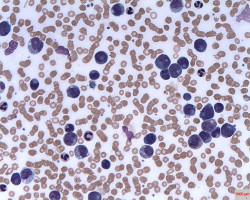
A large, new study of adults with acute myeloid leukaemia (AML) correlates 80 cancer-related gene mutations with five subtypes of AML, which are defined by the presence of specific chromosomal abnormalities.
The findings might help guide mutation testing and treatment decisions in the future.
Led by researchers at The Ohio State University Comprehensive Cancer Center - Arthur G. James Cancer Hospital and Richard J. Solove Research Institute (OSUCCC - James), the study involved 1,603 newly diagnosed adult AML patients, who were treated on Cancer and Leukaemia Group B/Alliance for Clinical Trials in Oncology trials in multiple centers across the United States.
The researchers combined the cytogenetic abnormalities that define each of 34 AML subgroups with the mutation status of the 80 cancer-related genes to produce an "oncoprint," a compact tabular summary of the gene mutations associated with each cytogenetic group.
Reported in the journal Leukaemia, the findings identify:
"Our study summarises cytogenetic and mutational information of 1,603 AML patients in a single image," says first author and OSUCCC - James researcher Ann-Kathrin Eisfeld, MD, a member of Ohio State's Internal Medicine/Physician-Scientist Training Program. "The identification of key mutational features of each subgroup may help us to better understand the pathogenesis of the different AML types and provides a wealth of information for ongoing and future research."
Senior investigator Clara D. Bloomfield, MD, Distinguished University Professor, Ohio State University Cancer Scholar and Senior Adviser to the OSUCCC - James, adds "If our findings are confirmed, it may mean that our mutational oncoprint may help to guide mutation testing and potentially even future treatment decisions for patients."
For this study, Eisfeld, Bloomfield and their colleagues obtained pretreatment bone marrow or peripheral blood samples from each patient. Of the patients, 1,080 were under age 60, and 523 were 60 years or older.
All received similar treatment through Cancer and Leukaemia Group B clinical trials.
Each patient's diagnosis placed him or her into one of five AML types and one of 34 subgroups, according to the presence or absence of specific chromosomal abnormalities in the person's leukaemic cells. (AML patients with no chromosomal abnormalities are classified as having cytogenetically normal AML [CN-AML].)
The patients' leukaemic cells were sequenced to learn the mutational status of 80 cancer- and leukaemia-related genes.
The mutations were assigned to one of nine categories based on the gene's biological function (e.g., methylation-related, cohesin complex, chromatin remodelling, tumour-suppressor genes).
The researchers identified 4,390 gene mutations in the patient cohort, with a median three mutations per patient.
Overall, the most frequently mutated genes that contributed to AML in this cohort belonged to the methylation group.
Key genetic differences revealed by the mutational oncoprint include:
We are an independent charity and are not backed by a large company or society. We raise every penny ourselves to improve the standards of cancer care through education. You can help us continue our work to address inequalities in cancer care by making a donation.
Any donation, however small, contributes directly towards the costs of creating and sharing free oncology education.
Together we can get better outcomes for patients by tackling global inequalities in access to the results of cancer research.
Thank you for your support.